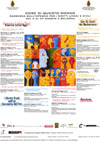
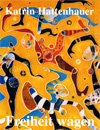
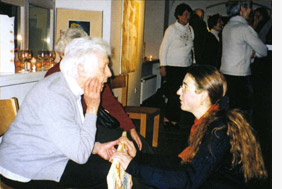 Freya von Moltke
Freya von MoltkeForeword
The International Education and Youth Encounter Centre in Kryzowa/ Kreisau, Poland was officially opened in 1998. But a group with members from Poland, East and West Germany, Holland, and America had already begun work in 1988 with the goal of bringing new life to the almost forgotten village now named Kryzowa, which during the period of National Socialism had been the meeting point of the Kreisau Circle resistance group.
The political changes in Eastern Europe made it possible to create a meeting place for young people from all over Europe at the former estate. Civil courage and commitment to the basic principles of a democratic society were the hallmarks of the Kreisau Circle. Thus Kreisau has come to symbolise courage - courage shown in hard times. My friends from Kreisau were only a few of those involved. Kryzowa should also represent all those people in Poland, the Czech Republic, Russia and other countries who fought against dictators in difficult times. Against this background, the events that are now organised in Kryzowa are intended to stimulate European understanding. We hope to contribute to the growing together of European youth in the new Europe.
 Helmut Steiner
Helmut SteinerThe Dance and the City
Remarks about Katrin Hattenhauer's art
“You see, transient happiness is not happiness. Happiness exists only in eternity. The rest is movies and jazz ...” (from Mircea Eliade, Indisches Tagebuch, etc.)
Is it surprising how easy it is to take these words, found in a text of the philosopher and scholar of myths, also writer and world traveller Mircea Eliade (1907-1986), out of their original context and apply them to a piece of modern art? Not really. What artist is not dominated by myth and who does not seek above and beyond for something like eternity? The young artist Katrin Hattenhauer cannot be reduced to “movies and jazz”, however happy and free her pictures may seem, nor can her work be classed as Pop Art. The colours of her pictures, the structures of the surface and thus the formal arrangement of images are representative of popular art of our time. But there are also clear connections to non-European art, for example from South American native cultures, or the Hindu art of southern Asia. It is impossible to imagine early classical European modern art in the 20th century without such influences, along with African art. Seen in this light, Katrin Hattenhauer's exotic images of the body create an almost mythical understanding of aesthetic beauty. This goal has become an aesthetic programme. But that is not all. Above and beyond this, the artist shows that the visual arts in the age of globalization can certainly achieve non-digitalised effects.
The confident use of materials, which, in their free rhythm are nearly playful, and a colour scheme calling forth archaic models create a new world of images, determine the creative work and also reflect the personality of the artist.
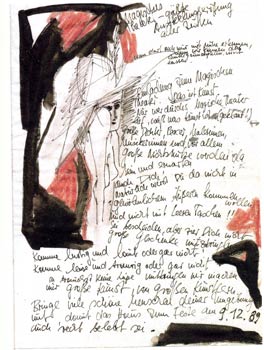
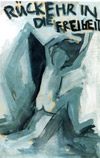
Katrin Hattenhauer was an active participant in shaping these social changes. One insight gained by this experience was that there is truly a freedom to desire, even though this liberty as well was quickly reigned in. What remained, however, was the conscious desire to realize this feeling of freedom in the future. Two possibilities arose from this – politics and art. And although Katrin Hattenhauer chose the latter, she continues to understand herself today as a politically motivated person, distanced from the demogogue’s easy thinking. However, the question remains as to whether Katrin Hattenhauer’s images are themselves too direct. The answer is “yes”, and the artist is willing to admit to this, since the essence of her current image inventory lies in the ability of the viewer to recognize immediately in all clarity what she sees. Directness is the means to an end. This formal consequence may impress but nonetheless renounces all artificiality.
In addition, the oeuvre presented in this exhibition can be divided into three significant groups: the dance in the form of images of the body, which has already been mentioned, the city as a lyric deconstruction, and the almost anecdotal creation of images. One formal characteristic of all three groups of works is that the images presented are in motion. That is, any static aspects and the excessive prominence of the subject is consciously avoided. Here, fully in the archaic sense, any notion of perspective is renounced. This desire to form is supported by the technical means of artistic production, these never become ends in and of themselves. This applies to the plywood used, or the yarn or those paintings in which wood shavings are applied to jute or canvas and primary colours which are plastically contoured by the internal structure of the yarn.
Katrin Hattenhauer has now arrived as an artist.
As an old and new resident of Kreisau I would like express my pleasure at Katrin Hattenhauer’s beautiful and moving exhibition in the Kreisau Foundation in Kryzowa in Polish Silesia.
Katrin Hattenhauer was not only present to show her artistic work. She was also here to work creatively with young east and west European people. The title of the exhibition, Daring Freedom, was at the same time a motto for the time shared with the young people from Lithuania, Poland, and Germany.
Hattenhauer's workshop is like a trial run for reality: brushes and paint are used to settle differences and discuss about attitudes and opinions, plans and visions are developed on paper. During this work, a community has formed and friendships which will last beyond the duration of the workshop. Differences were lived out spontaneously and creatively, commonalities discovered, prejudices overcome, and common goals found.
Katrin Hattenhauer brought her art, her talent as a teacher and her empathy with young people into the project and so helps us new residents of Kreisau in our goal of promoting better understanding in Europe.
“Daring Freedom”
Krzyzowa/Kreisau/Polen November/December/ 2003
“Return to Freedom”
Nikolaikirche Leipzig 1999
“Loving Couple Project”
Essenheimer Kunstverein
23/06 - 09/07/2006
“Cose di Questo Mondo”
Bologna
2 - 27/5/2006
“Inno alla Libertà”
Bologna
2 - 12/10/2005

“Magic Theatre” Leipzig
9/12/1989
